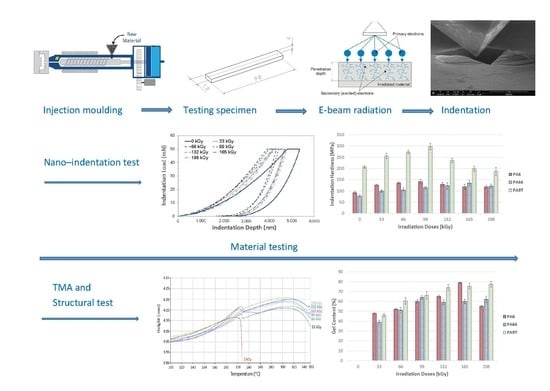Polyamide Surface Layer Nano-Indentation and Thermal Properties Modified by Irradiation
Abstract
1. Introduction
2. Materials and Methods
2.1. Materials
2.2. Sample Preparation
2.3. Irradiation
2.4. Nano-Indentation Test
2.5. Gel Content
- Dimensions and polydispersion grow in the first phase.
- At a certain point, the reaction reaches a gel point in which the molar weight increases beyond all limits and the gel starts to appear in the system.
- After bypassing the gel point, the system is composed of two parts: on the one hand, an infinite structure called a “gel”; on the other, a cluster of molecules with finite size called a “sol”. These molecules can be separated from the gel by extraction.
- Complete networks, by-products and micro-gel cannot be extracted. The gel is insolvable and if exposed to a solvent, it experiences imbibitions.
- Finally, the sol content, as well as its molar weight and polydispersity, decreases as the reaction continues.
- Active elastic chains are created within the gel network. These chains support the applied stress, thus determining the gel elastic modulus value and its equilibrium degree imbibitions.
2.6. Thermo-Mechanical Analysis (TMA)
3. Results
3.1. Nano-Mechanical Properties (Indentation Depth, Hardness, Modulus and Creep)
3.2. Thermo-Mechanical Analysis
3.3. Gel Content
4. Conclusions
Author Contributions
Funding
Conflicts of Interest
References
- Ovsik, M.; Manas, M.; Stanek, M.; Dockal, A.; Mizera, A.; Fluxa, P.; Bednarik, M.; Adamek, M. Nano-Mechanical Properties of Surface Layers of Polyethylene Modified by Irradiation. Materials 2020, 13, 929. [Google Scholar] [CrossRef]
- Tabata, Y.; Ito, Y.; Tagawa, S. (Eds.) CRC Handbook of Radiation Chemistry; CRC Press: Boca Raton, FL, USA, 1991. [Google Scholar]
- Makuuchi, K. Critical review of radiation processing of hydrogel and polysaccharide. Radiat. Phys. Chem. 2010, 79, 267–271. [Google Scholar] [CrossRef]
- Ivanov, V. Radiation Chemistry of Polymers; VSP: Utrecht, The Netherlands, 1992. [Google Scholar]
- Zhang, L.H.; Qi, Y.C.; Yu, L.; Li, S.Z.; Chen, D.L. Radiation Effects on Crystalline Polymers—I, Crystallinity Dependence of Chemical Reaction in Irradiated Polyamide-1010. Radiat. Phys. Chem. 2001, 36, 743–746. [Google Scholar]
- Woods, R.J.; Pikaev, A.K. Applied Radiation Chemistry: Radiation Processing; Wiley-Interscience Publication: New York, NY, USA, 1994; ISBN 0-471-54452-3. [Google Scholar]
- Sun, J.Z. The Effect of Chain flexibility and Chain Mobility on Radiation Crosslinking of Polymers. Radiat. Phys. Chem. 2001, 60, 445–451. [Google Scholar]
- Lyons, B.J.; Glover, L.C., Jr. Radiolytic crosslinking and chain scission in aliphatic and alkyl-aromatic polyamides. Part I. Radiat. Phys. Chem. 1990, 35, 139–147. [Google Scholar] [CrossRef]
- ChmielewskiI, A.G.; Haji-Saeid, M.; Ahmed, S. Progress in radiation processing of polymers. Nucl. Instrum. Methods Phys. Res. B 2005, 236, 44–54. [Google Scholar] [CrossRef]
- Makuuchi, K.; Cheng, S. Radiation Processing of PolymerMaterials and its Industrial Applications; John Wiley & Sons, Inc.: Hoboken, NJ, USA, 2012; ISBN 978-0-470-58769-0. [Google Scholar]
- Brocka, Z. Werkstoff- und Einsatzpotential Strahlenvernetzter Thermoplaste; Lehrsthul für Kunststofftechnik (LKT): Nuremberg, Germany, 2008. [Google Scholar]
- Feng, W.; Hu, F.M.; Yuan, L.H.; Zhou, Y.; Zhou, Y.Y. Radiation crosslinking of polyamide 610. Radiat. Phys. Chem. 2002, 63, 493. [Google Scholar] [CrossRef]
- Deeley, C.W.; Woodwar, A.E.; Sauer, J.A. Effect of irradiation on dynamic mechanical properties of 6-6 nylon. J. Appl. Phys. 1957, 28, 1124–1130. [Google Scholar] [CrossRef]
- Ferra, W.P.; Leonardo, G.A.S. Ionizing radiation effect studies on polyamide 6.6 properties. Radiat. Phys. Chem. 2004, 71, 267–269. [Google Scholar] [CrossRef]
- Pinto, C.; Andrade e Silva, L.G. Study of ionizing radiation on the properties of polyamide 6 with fiberglass reinforcement. Radiat. Phys. Chem. 2007, 76, 1708–1710. [Google Scholar] [CrossRef]
- Pramanik, N.K.; Haldar, R.S.; Bhardwaj, Y.K.; Sabharwal, S.; Noyogi, U.K.; Khandal, R.K. Radiation processing of Nylon-6 by e-beam for improved properties and performance. Radiat. Phys. Chem. 2009, 78, 199–205. [Google Scholar] [CrossRef]
- Burrillo, G.; Adem, E.; Munoz, E.; Vásquez, M. Electron beam irradiated polyamide-6 at different temperature. Radiat. Phys. Chem. 2013, 84, 140–144. [Google Scholar] [CrossRef]
- Feulner, R.; Brocka, Z.; Seefried, A.; Kobes, M.O.; Hulder, G.; Osswald, T.A. The effects of e-beam irradiation induced cross-linking on the friction and wear of polyamide 66 in sliding contact. Wear 2010, 268, 905–9010. [Google Scholar] [CrossRef]
- Dadbin, S.; Frounchi, M.; Goudarzi, D. Electron beam induced crosslinking of nylon 6 with and without the presence of TAC. Polym. Degrad. Stab. 2005, 89, 436–441. [Google Scholar] [CrossRef]
- Porubska, M.; Szollos, O.; Konova, A.; Janigova, I.; Jaskova, M.; Jomova, K.; Chodak, I. FTIR spectroscopy study of polyamide-6 irradiated by electron and proton beams. Polym. Degrad. Stab. 2012, 97, 523–531. [Google Scholar] [CrossRef]
- Mehnert, R. Electron beams in research and technology. Nucl. Instrum. Methods Phys. Res. B 1995, 105, 348–358. [Google Scholar] [CrossRef]
- Timus, D.M.; Cincu, C.; Bradley, D.A.; Cracium, G.; Mateescu, E. Modification of some properties of polyamide-6 by elcectron bema induced grafting. Appl. Radiat. Isot. 2000, 53, 937–944. [Google Scholar] [CrossRef]
- Karstens, T.; Rossbach, V. Thermo-oxidative degradation of polyamide 6 and 6,6. Kinetics of the formation and inhibition of UV/VISactive chromophores. Die Makromol. Chem. 1989, 190, 12. [Google Scholar] [CrossRef]
- Kaindl, K.; Graul, E.H. Strahlenchemie, Dr. Alfred Hüttig; Verlag: Heildelberg, Germany, 1967. [Google Scholar]
- Mleziva, J. Polymers—Production, Structure, Properties and Applications; Sobotales: Prague, Czech Republic, 1993. [Google Scholar]
- Shin, B.Y.; Ha, M.H.; Han, D.H. Morphological, Rheological, and Mechanical Properties of Polyamide 6/Polypropylene Blends Compatibilized by Electron-Beam Irradiation in the Presence of a Reactive Agent. Materials 2016, 9, 342. [Google Scholar] [CrossRef]
- Pramanik, N.K.; Haldar, R.S.; Niyogi, U.K.; Alam, M.S. Development of an Advanced Engineerign Polymer from the Modification of Nylon 66 by E-Beam Irradiation. Def. Sci. J. 2014, 64, 281–289. [Google Scholar] [CrossRef][Green Version]
- Uddin, J.A.; Gotoh, Y.; Ohkoshi, Y.; Nishino, T.; Endo, R. Crystal Modulus of a New Semiaromatic Polyamide 9-T. Polym. Eng. Sci. 2011, 331–337. [Google Scholar] [CrossRef]
- Porubska, M.; Janigova, I.; Jomova, K.; Chodak, I. The Effect of Electron Beam Irradiation on Properties of Virgin and Glass Fiber-reinforced Polyamide 6. Radiat. Phys. Chem. 2014, 102, 159–166. [Google Scholar] [CrossRef]
- Oliver, W.C.; Pharr, G.M. Measurement of hardness and elastic modulus by instrumented indentation: Advances in understanding and refinements to methodology. J. Mater. Res. 2004, 19, 3–20. [Google Scholar] [CrossRef]
- Manas, D.; Mizera, A.; Navratil, J.; Manas, M.; Ovsik, M.; Sehnalek, S.; Stoklasek, P. The electrical, mechanical and surface properties of thermoplastic polyester elastomer modified by electron beta radiation. Polymers 2018, 10, 1057. [Google Scholar] [CrossRef]
- Manas, D.; Mizera, A.; Manas, M.; Ovsik, M.; Hylova, L.; Sehnalek, S.; Stoklasek, P. Mechanical properties changes of irradiated thermoplastic elastomer. Polymers 2018, 10, 87. [Google Scholar] [CrossRef] [PubMed]
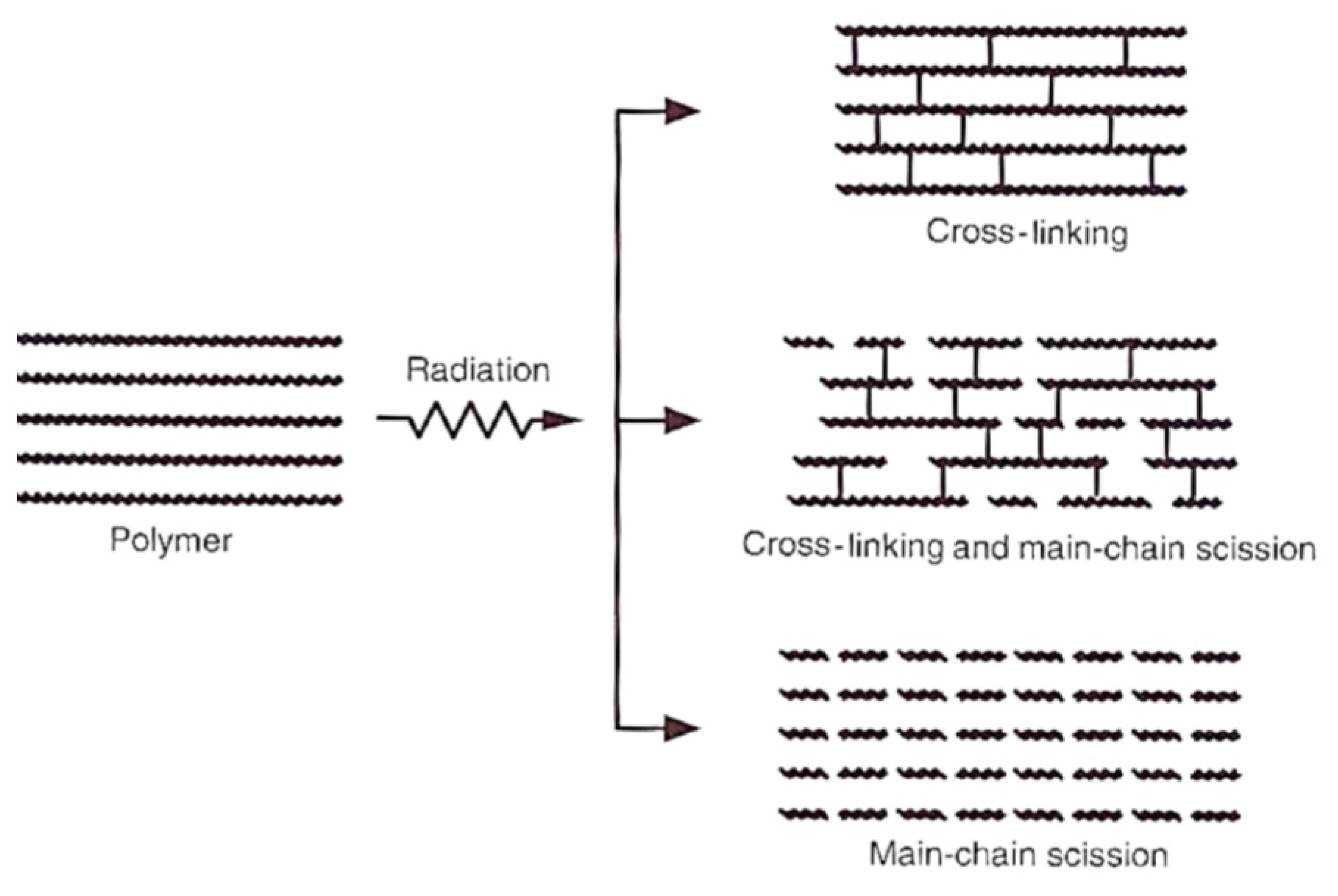
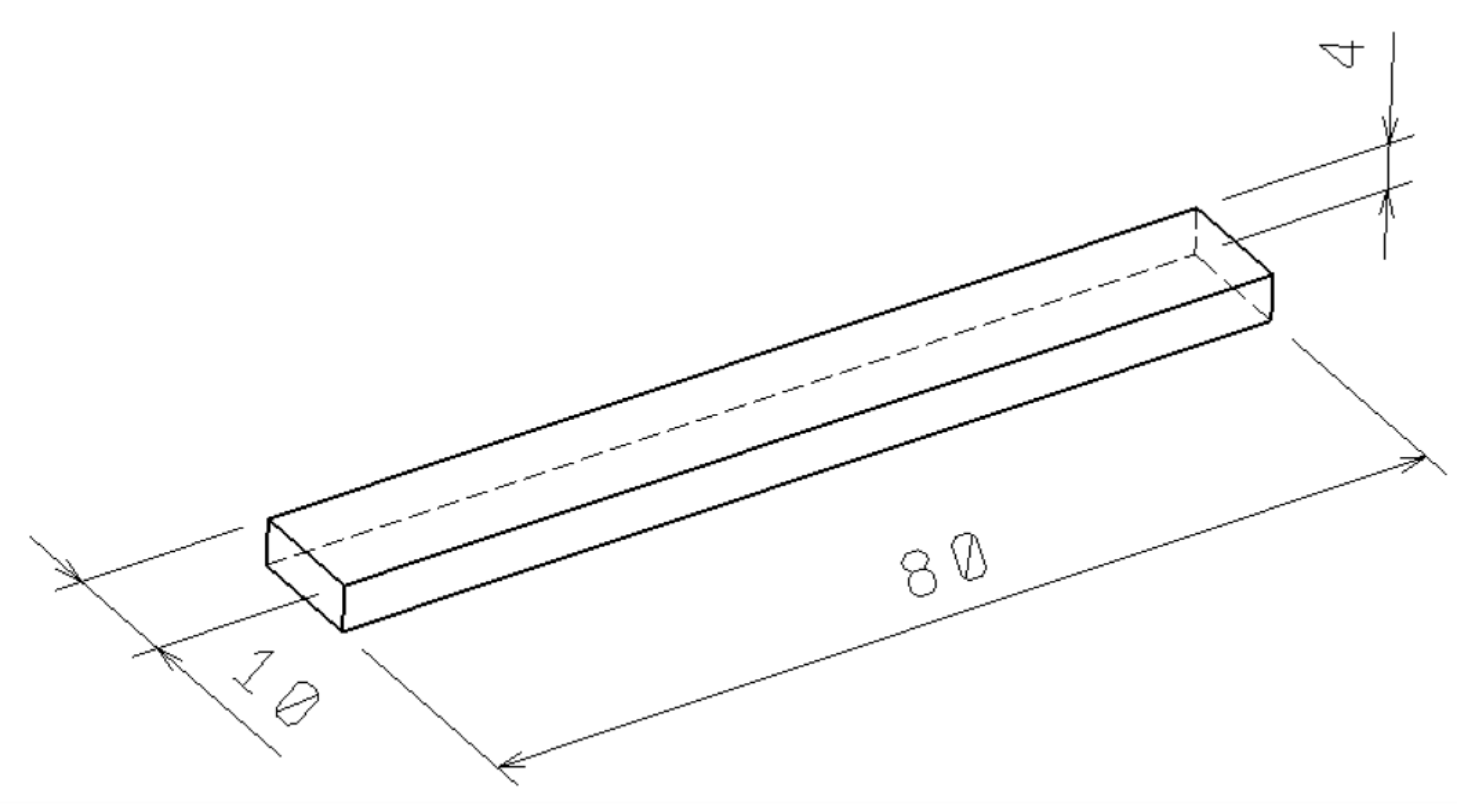
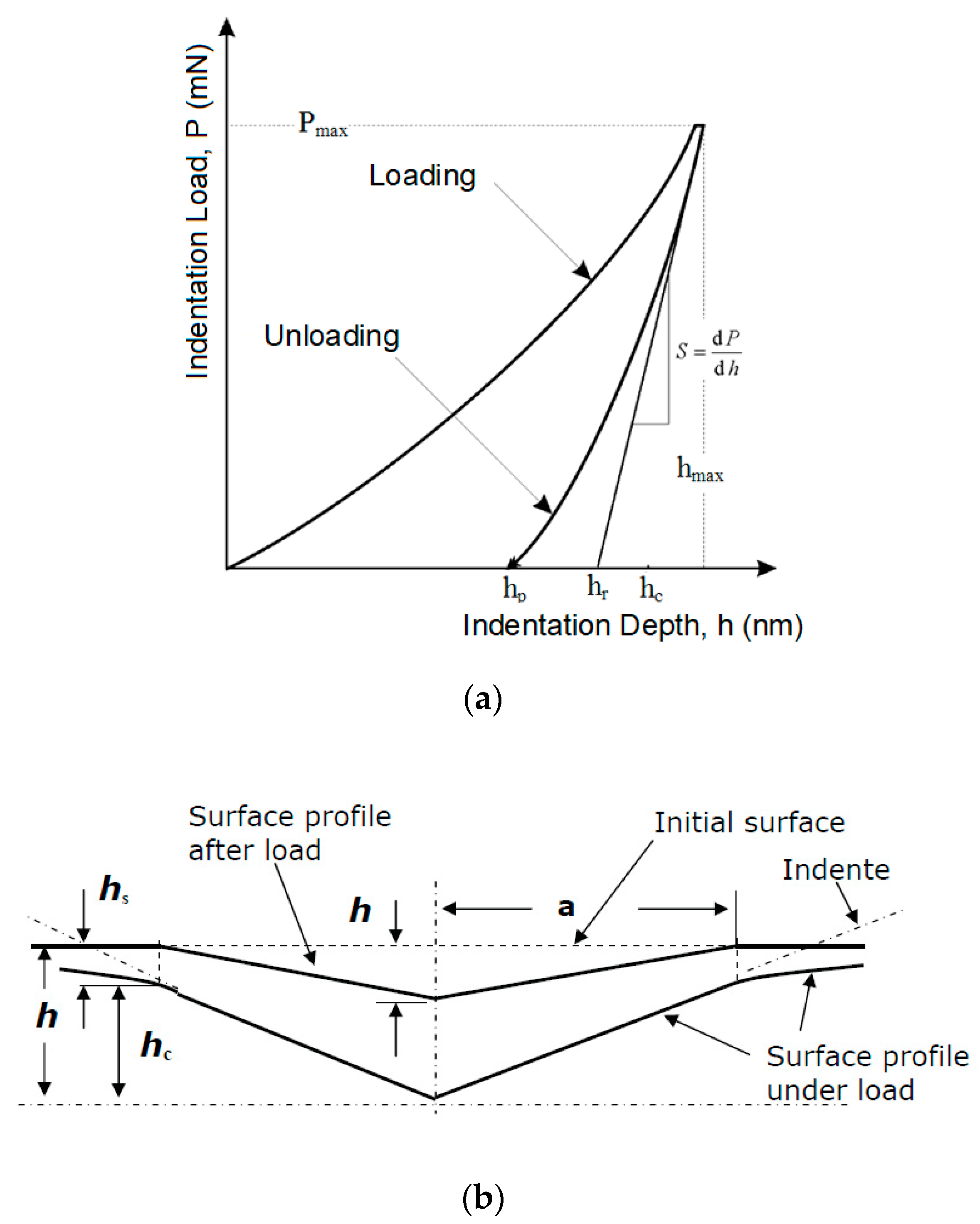
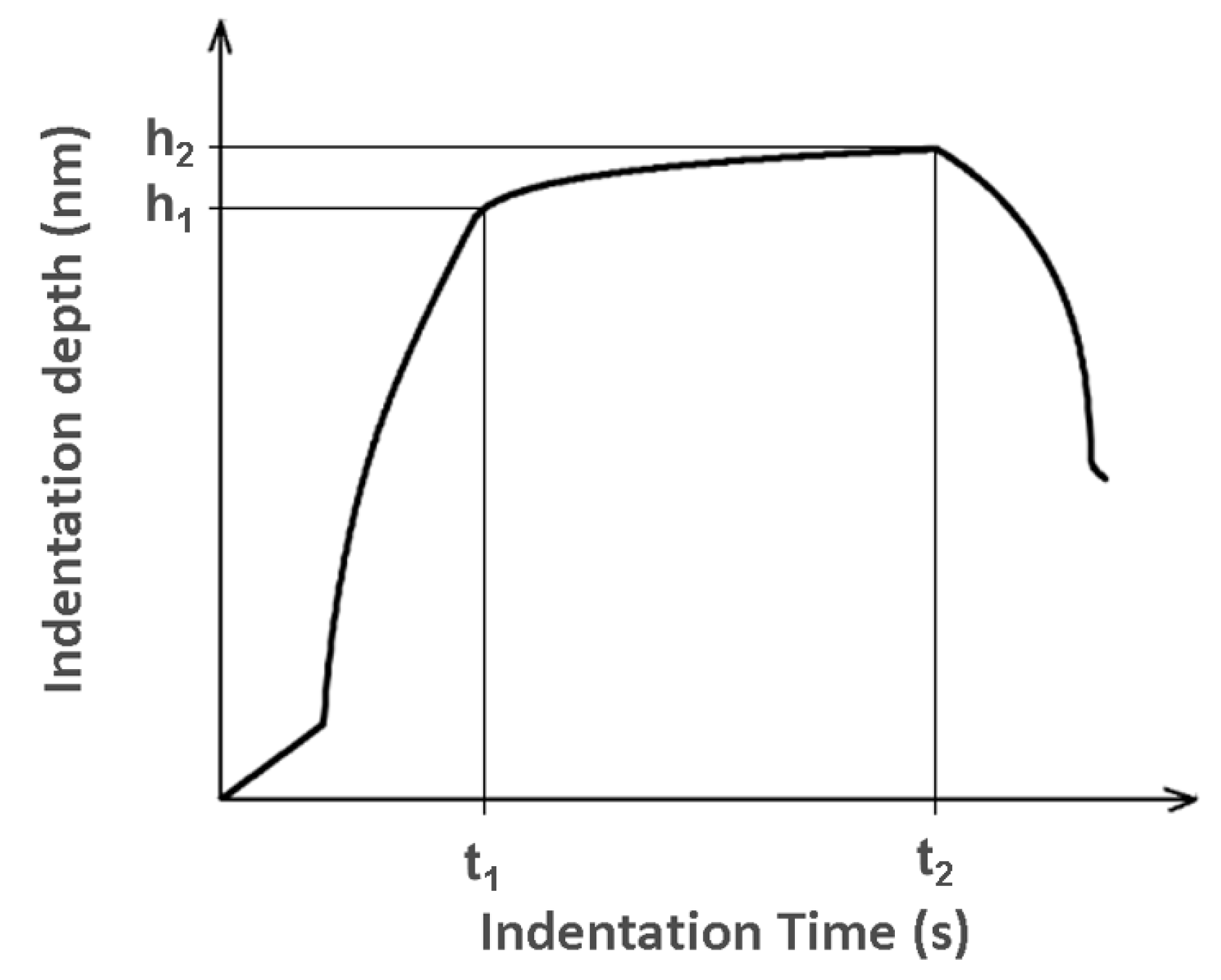
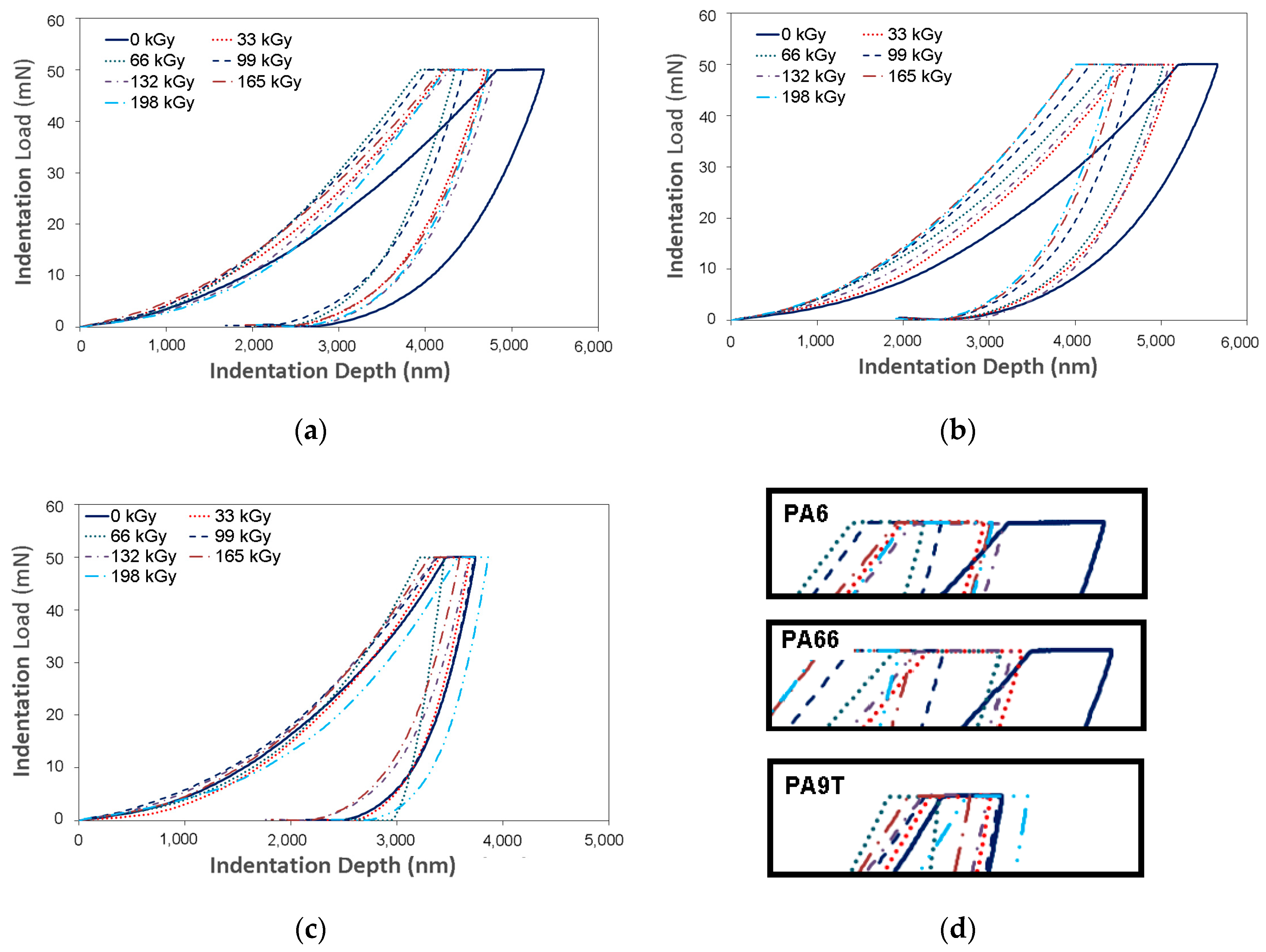
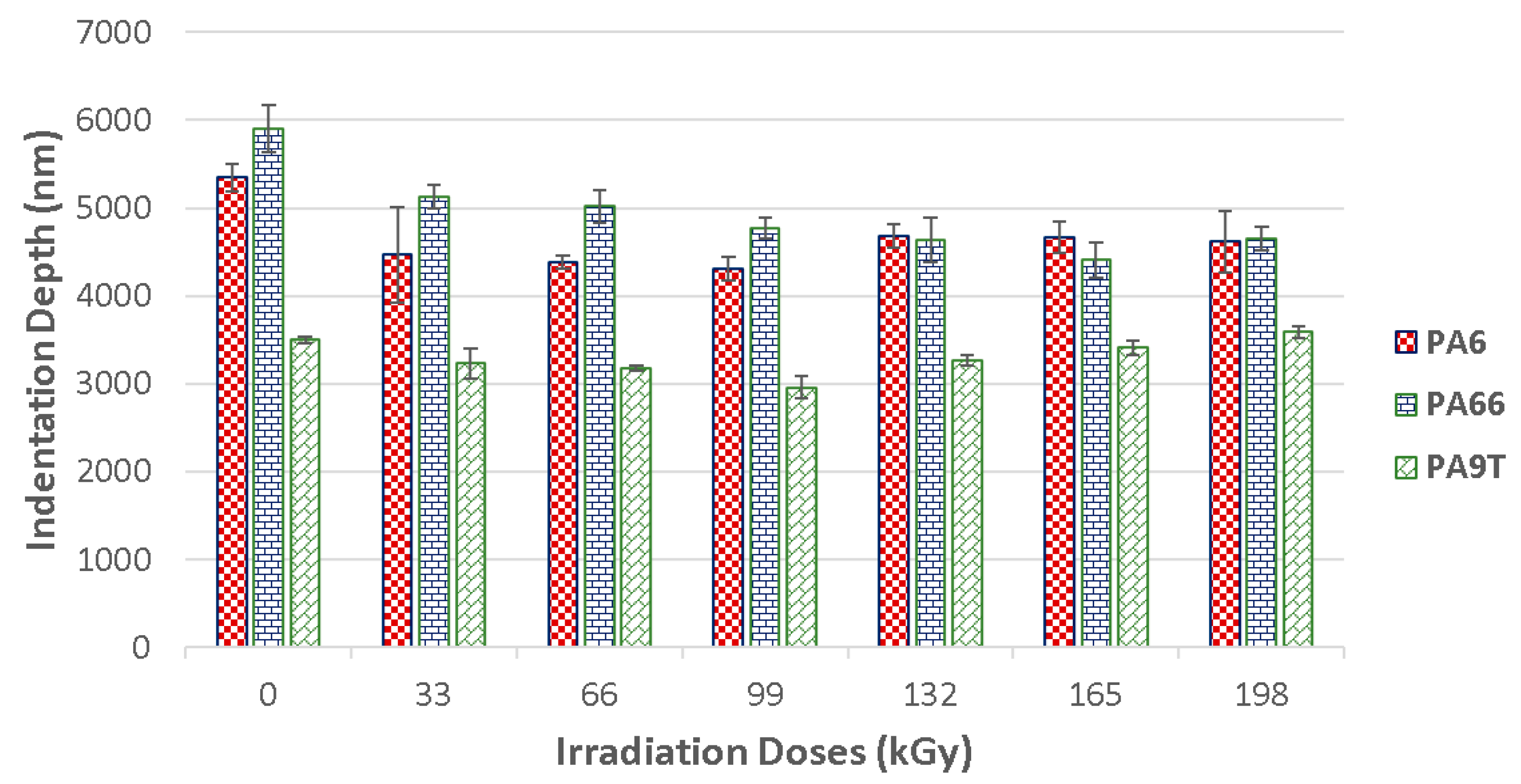
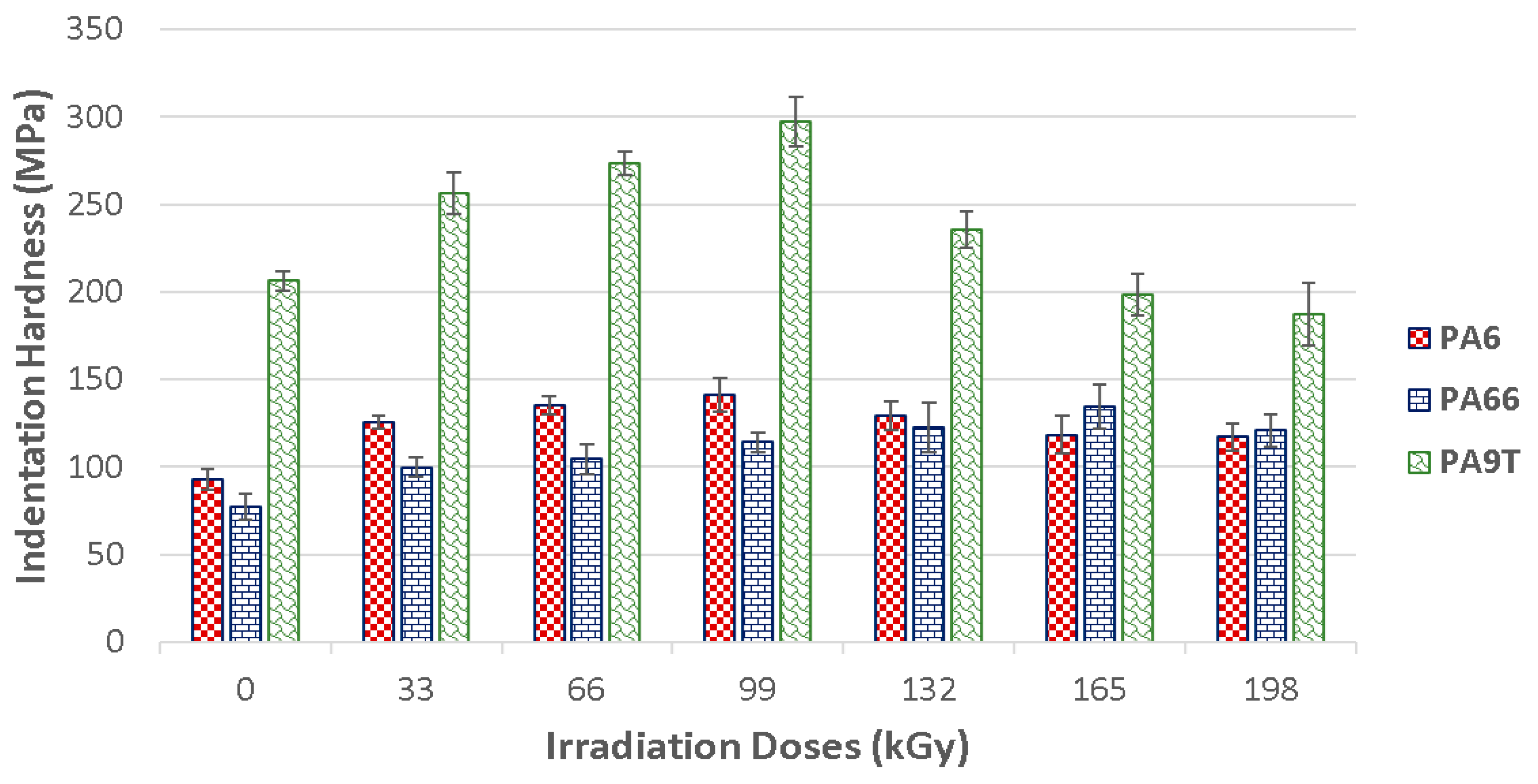
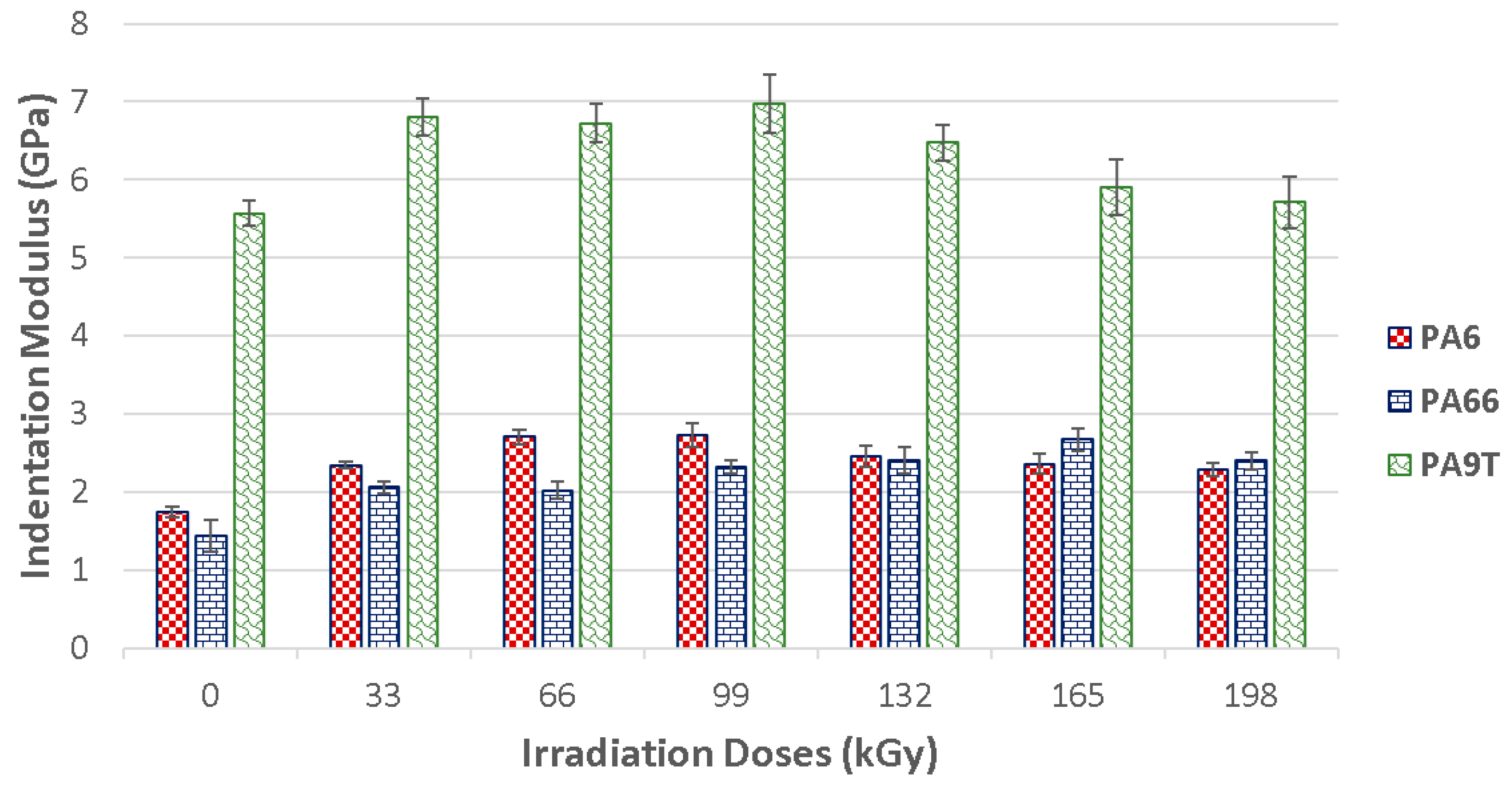
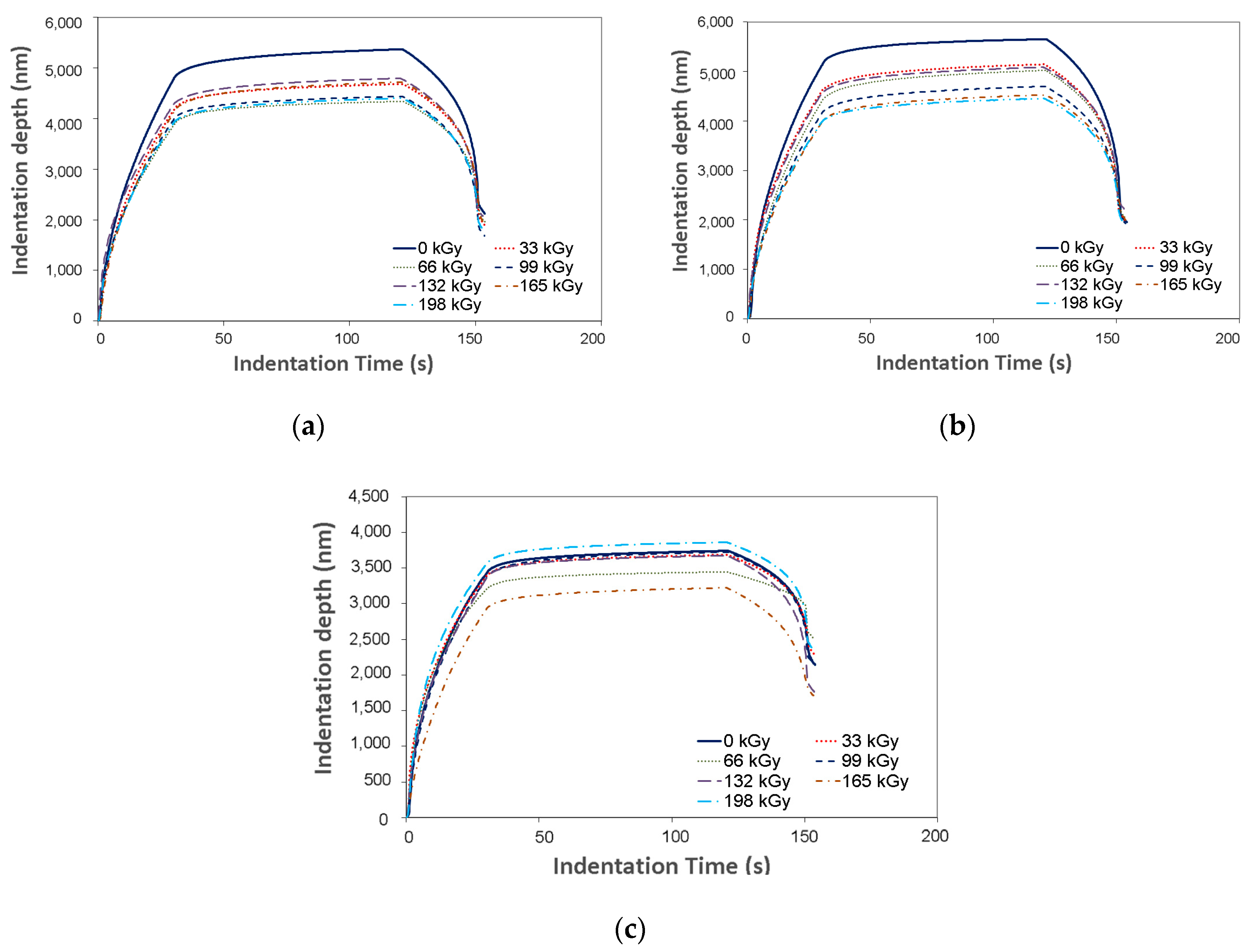
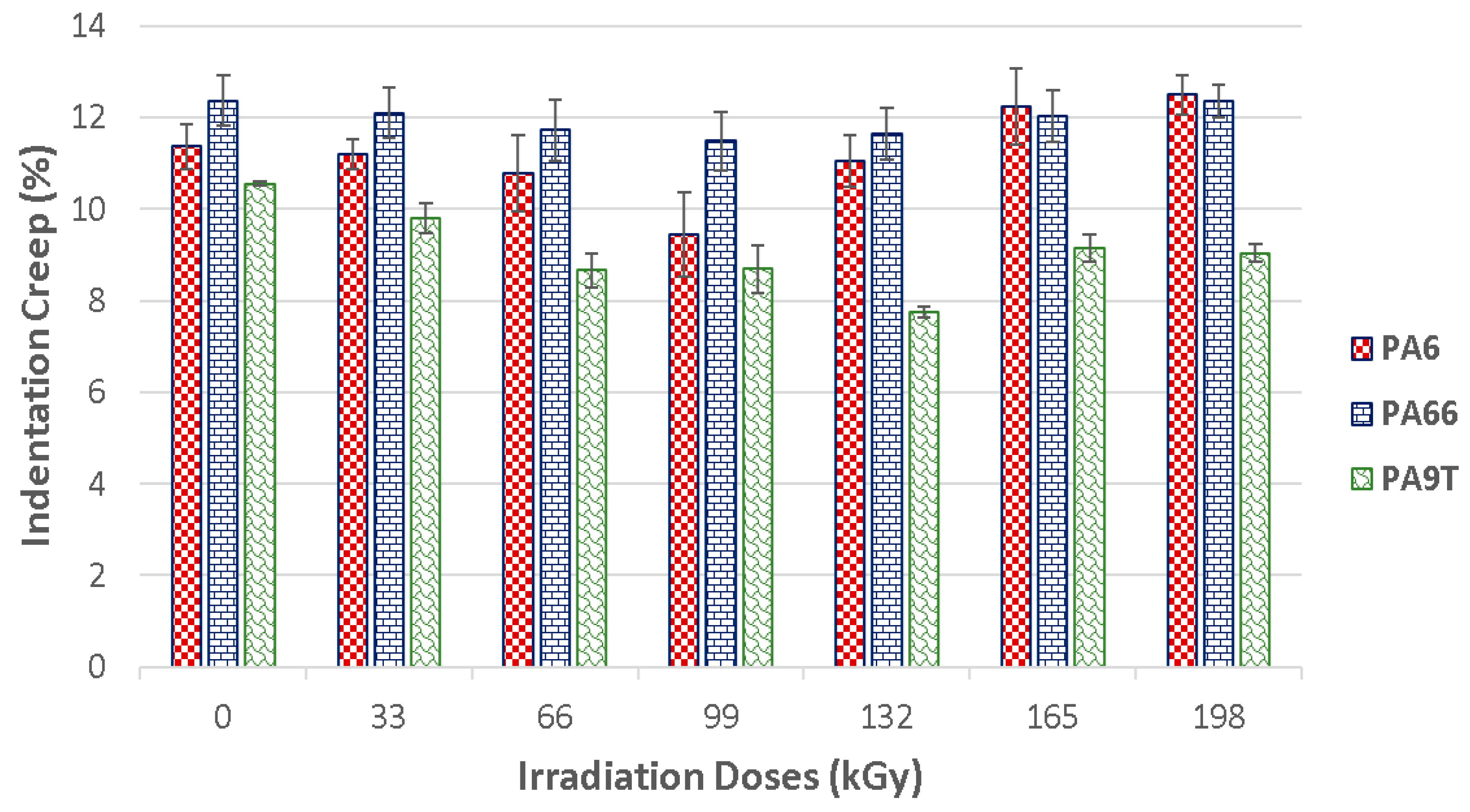
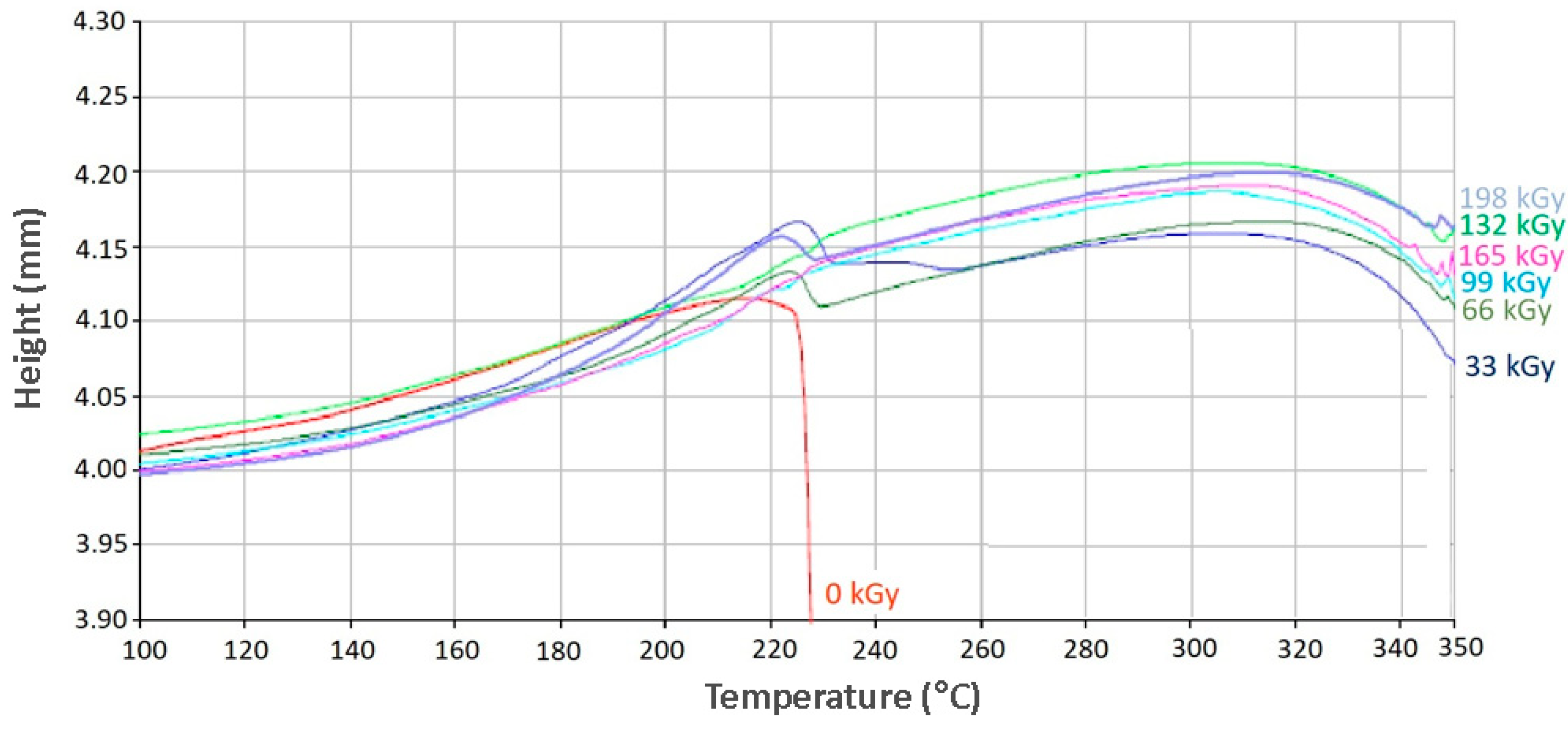
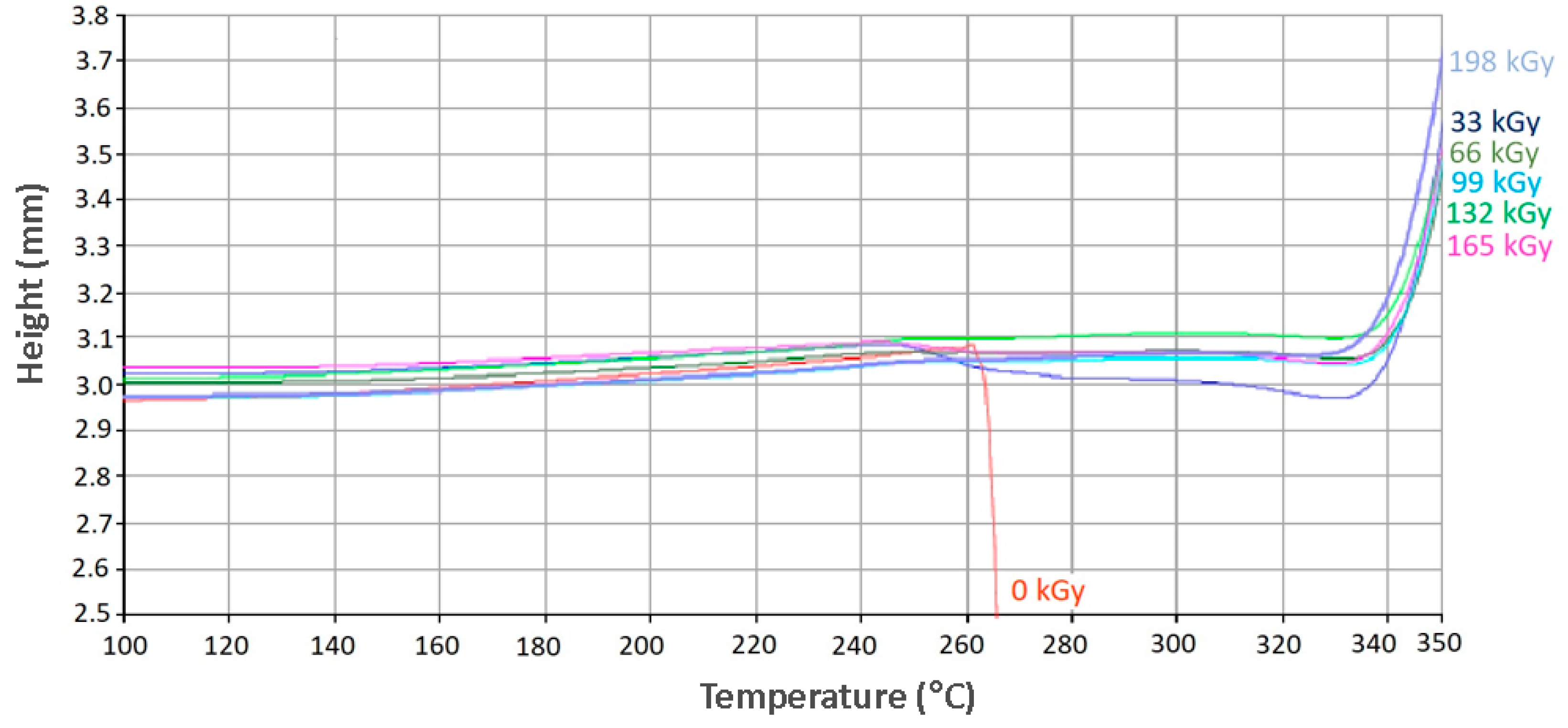
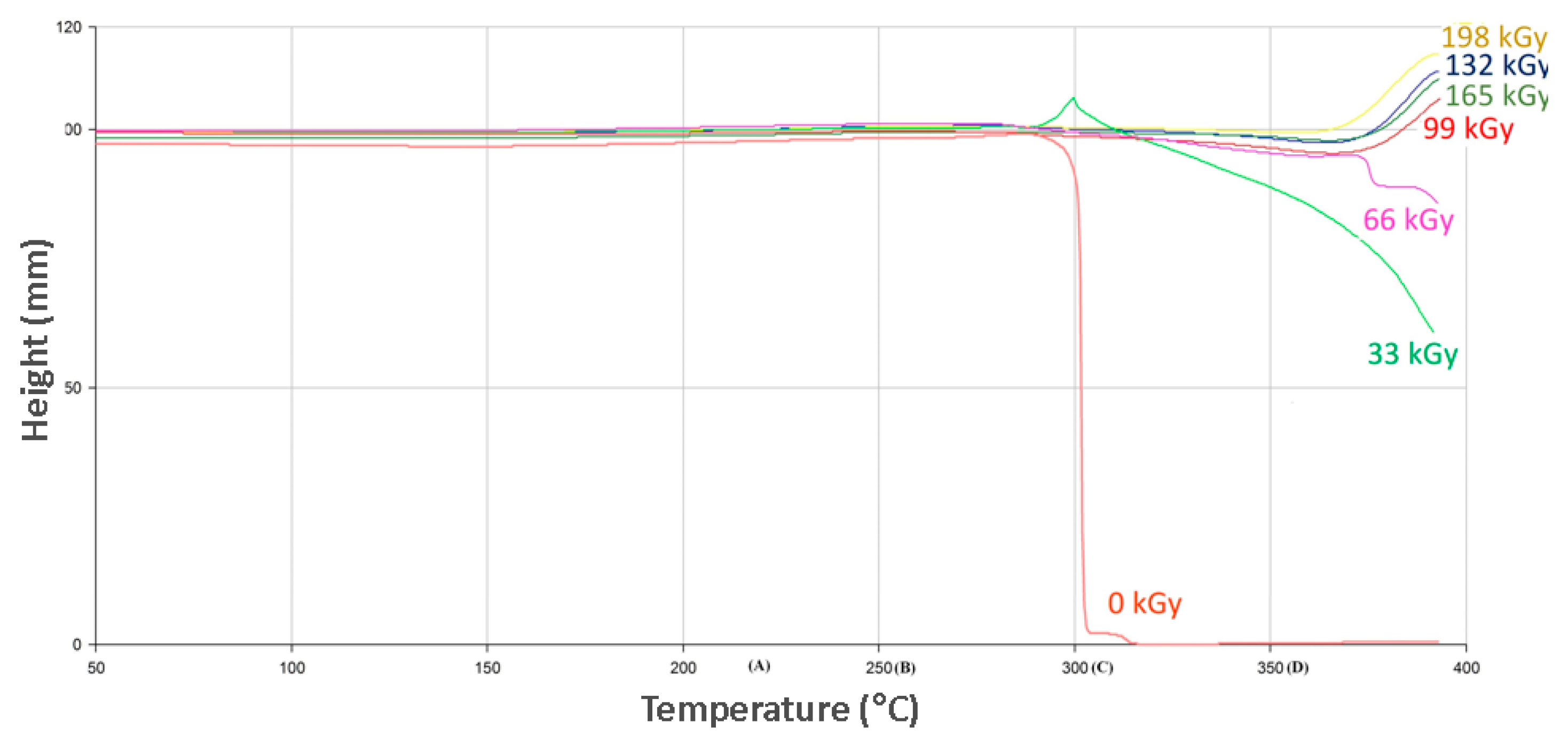
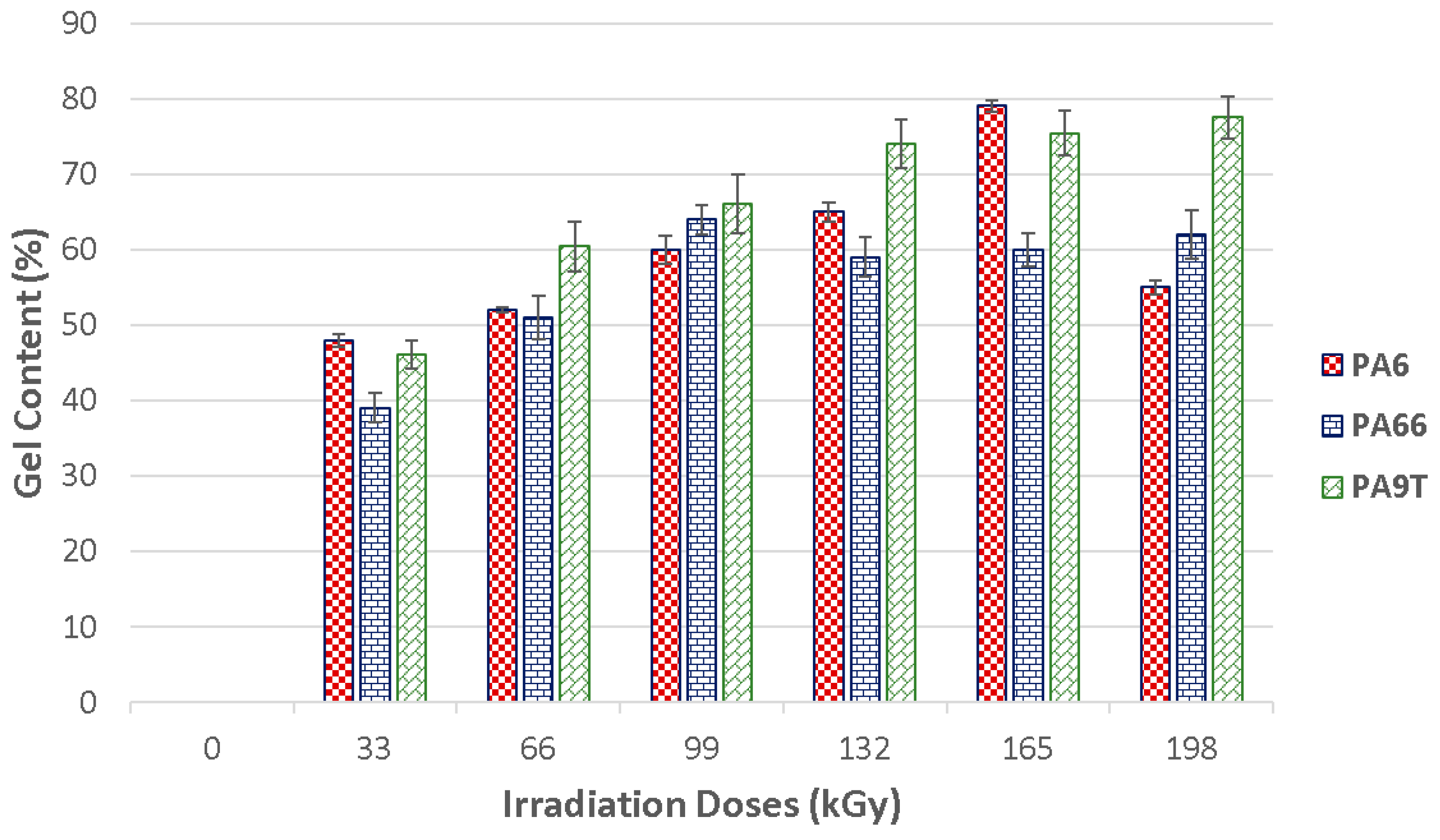
| Type of Polymers | Trade Name | Company |
|---|---|---|
| Polyamide 6 | PA 6 (V-PTS-CREAMID-B3H2*M800/14 natur) | PTS (Adelshofen, Germany) |
| Polyamide 66 | PA 66 (V-PTS-CREAMID-A3H2*M710 A/14 natur) | PTS (Adelshofen, Germany) |
| Polyamide 9T | PA 9T (V-PTS-DURAMID-9TH2G9*M800/13 natur) | PTS (Adelshofen, Germany) |
| Process Parameter | PA 6 | PA 66 | PA 9T |
|---|---|---|---|
| Injection rate (mm/s) | 50 | 50 | 50 |
| Injection pressure (MPa) | 80 | 80 | 170 |
| Cooling time (s) | 20 | 20 | 25 |
| Mold temperature (°C) | 90 | 90 | 140 |
| Holding time (s) | 20 | 20 | 15 |
| Barrel temperature—Zone 1 (°C) | 220 | 245 | 295 |
| Barrel temperature—Zone 2 (°C) | 230 | 260 | 305 |
| Barrel temperature—Zone 3 (°C) | 245 | 275 | 315 |
| Barrel temperature—Zone 4 (°C) | 255 | 285 | 325 |
| Parameters | Unit | Value |
|---|---|---|
| Maximum load | mN | 50 |
| Load/unload speed | mN/min | 100 |
| Holding time (HIT, EIT) | s | 90 |
| Holding time (CIT) | s | 21,600 |
© 2020 by the authors. Licensee MDPI, Basel, Switzerland. This article is an open access article distributed under the terms and conditions of the Creative Commons Attribution (CC BY) license (http://creativecommons.org/licenses/by/4.0/).
Share and Cite
Ovsik, M.; Manas, M.; Stanek, M.; Dockal, A.; Vanek, J.; Mizera, A.; Adamek, M.; Stoklasek, P. Polyamide Surface Layer Nano-Indentation and Thermal Properties Modified by Irradiation. Materials 2020, 13, 2915. https://doi.org/10.3390/ma13132915
Ovsik M, Manas M, Stanek M, Dockal A, Vanek J, Mizera A, Adamek M, Stoklasek P. Polyamide Surface Layer Nano-Indentation and Thermal Properties Modified by Irradiation. Materials. 2020; 13(13):2915. https://doi.org/10.3390/ma13132915
Chicago/Turabian StyleOvsik, Martin, Miroslav Manas, Michal Stanek, Adam Dockal, Jiri Vanek, Ales Mizera, Milan Adamek, and Pavel Stoklasek. 2020. "Polyamide Surface Layer Nano-Indentation and Thermal Properties Modified by Irradiation" Materials 13, no. 13: 2915. https://doi.org/10.3390/ma13132915
APA StyleOvsik, M., Manas, M., Stanek, M., Dockal, A., Vanek, J., Mizera, A., Adamek, M., & Stoklasek, P. (2020). Polyamide Surface Layer Nano-Indentation and Thermal Properties Modified by Irradiation. Materials, 13(13), 2915. https://doi.org/10.3390/ma13132915





